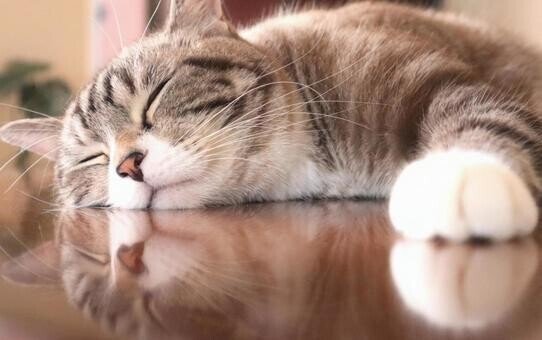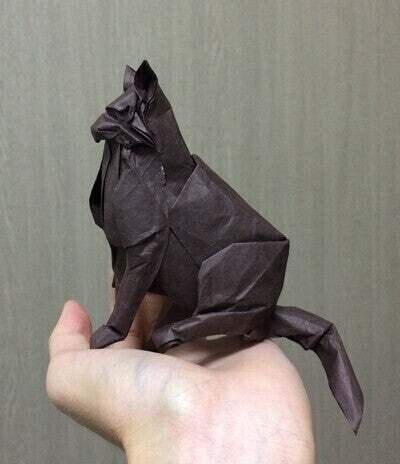
(EN) Cat '21 Commentary with CP
Introduction
Hi. I'm taiga, an origami artist.
This article is an explanation of my new work "Cat '21", which I tweeted on 2021/12/16.
猫の折り紙🐈
— taiga (@ngor_ong) December 16, 2021
まつ毛がチャームポイント pic.twitter.com/lAZ1vkxMEg
I've almost never talked about my origami works, but I decided to do so after this creation.
I say "almost" because I have a blog that I used to write when I was in junior high school. There were a lot of articles that I wrote when I was just a kid, and I still blush whenever I think of them (they've already disappeared from the Internet, so let's not go digging through the archives).
I'm a grown man writing this article, so I'm sure it won't be the same.
Attention
1. There is a charge for the explanation of the work with CP in the latter half.
2. There are no folding instructions.
In this article, I would like to write about my thought process during creation, so that people who don't usually do origami or creation can experience the process. I hope you will support this project if it suits your taste.
Origami and Cat
First of all, before I start explaining the work, I'd like to dig a little deeper into the subject of cats.
I think that cats are excellent subjects for origami works, or to broaden the word, for all kinds of creation and expression. Let me give you a few reasons.

First, they are well known. Along with dogs, they are widely recognized as representative pet animals. Of course, the fact that the subject matter is major is not essential to the creation process, but in many cases it is an advantage when considering how the work will be viewed and evaluated by others.

Next is diversity in appearance. Not only are there many different breeds, but there are also many different ways of sitting that have their own names, such as catloaf sitting, Egyptian sitting, and side sitting. Any one of them can be used as a motif for your cat artwork. It's a good deal.

And the loveliness. The amount of emotion an author feels toward the subject of his or her creation greatly affects motivation. Considering the total amount of love that is directed towards cats all over the world, it is inevitable that there will be an abundance of creative works based on cats.
My relationship with cats
I have been repeatedly working on creating cats. Since this is a good opportunity, I will introduce some of my past works.

This is one of the earliest recorded creations in 2014, when I was 18 years old. It was a time when I was trying to create a work that could be appreciated from all angles, and when I look at it now, I have the impression that I know what I want to do. I have the impression that it is well organized, but the details are not so well crafted. My interest in this line of work was later rekindled by Takashi Toyomura's "Shiba Inu", which led to the creation of my "Giraffe" and other works.
This is a creation from the following year. The subject was changed to a figure standing on all four legs, and I tried to create a supple, curved shape without much detail.

This is the CP of a 22.5-degree structure, but the folded lines that make up the feet do not converge at a single apex, giving a somewhat elusive impression.
This is the same basic structure, only with a different finishing touch. This is a much more realistic expression. We can clearly see the hesitation I had about my creative style at that time.
This was in 2016, when I became more conscious of the skeleton when creating. He seems to be trying to make clear folds in the finishing, and is gradually approaching the current method.

There have been some changes in the structure as well. In the past, my stance was as if to say "Don't worry about how hard it is to fold", and I was free to do whatever I wanted within the constraints of the angle system, but from this period, I started to intentionally avoid generating fold lines that deviate greatly from the Angular Grid System (Maekawa gami).
Strengthening the restrictions imposed on myself has the danger of narrowing the range of creation. However, I felt at the time that I was more comfortable with a method that looked for the best solutions in a more harmonious world, rather than unnecessarily going for acrobatics. As of 2022, I have settled into what can be called a moderate position.
The arrangement of the feet is exactly the same as Hideo Komatsu's lion. I don't remember the exact flow of thought at the time, but it may be an expression of my admiration for Mr. Komatsu, the pioneer of this style.
This one is a creation from 2017, the year after the previous one, and like the one from 2014, I chose a posture with the front legs extended (Egyptian sitting). I love how I was able to express the muscle ridges in detail with a relatively simple structure. After a lot of confusion about how to finish the face, I couldn't find anything satisfactory and had to call it quits.

This is the CP. There are fewer lines than in the previous works. The front and back legs are folded thickly at 67.5 degrees and 90 degrees, so it is difficult to tell at a glance what it is. Thanks to this feature, it was once used in a quiz on a Japanese TV program to guess the original work from its CP.
ここから先は
¥ 500
この記事が気に入ったらサポートをしてみませんか?
